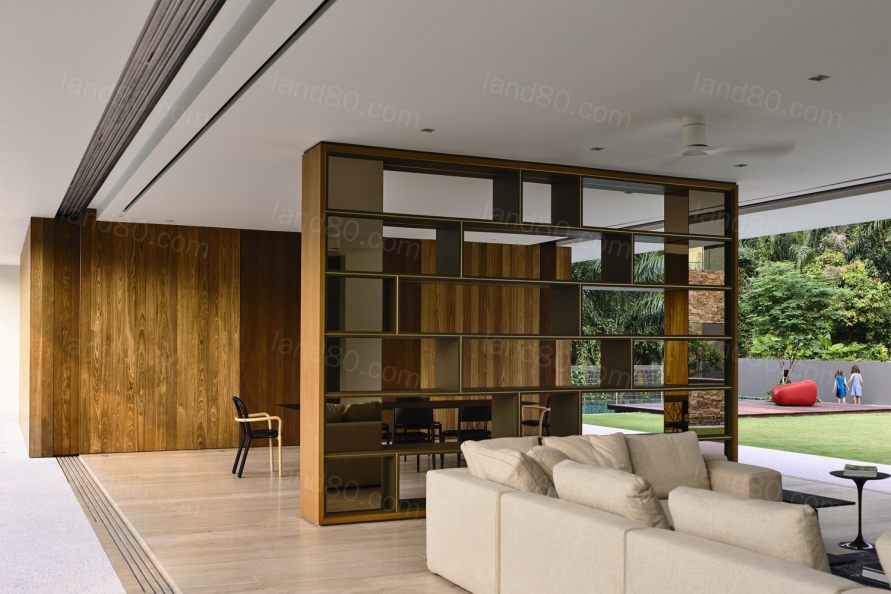项目坐落在一个装潢高雅的住宅区中,坐落在从旧马来亚铁路残骸生长出来的野生草原后面,曾经是一个经典的殖民地黑白平房的广阔花园,被想象成是现代热带生活的典范。
Reclined within a well-heeled residential enclave, KAP-House reposes behind wild grassland that grows from the remains of the old Malayan Railway. Placed on a plot that was once the sprawling garden of a classic colonial black and white bungalow, the home was imagined as a paradigm of modern tropical living.




场地现存的已经废弃的铁路,现在是一条保存完好的绿色走廊,提供了一个自然热带地形的背景。为了充分利用家里壮丽的环境之美,设计团队采用了日本的沙井设计原则,或称借景。他们的本意是创造一个在“大自然的相似性,捕捉大自然的活生生地创造一个壮观的景象”辉煌的家园。
The defunct railway, now a preserved green corridor, provides a backdrop of natural tropical terrain. Seeking to capitalise on the beauty of the home’s splendid surroundings, the design team adopted the Japanese design principle of Shakkei, or borrowed view. Their intention was to create a home resplendent in the “likeness of nature, capturing nature alive to create a spectacular vision”.




项目基于捕捉其奇妙的自然环境完全适应环境,因为建筑师仔细排列的家园,以强调借用的看法,绿色走廊。在设计团队考虑风向和太阳能定位等因素时,优先考虑了基本因素,引入了一个可持续的设计框架,允许在房屋方案中实施被动环境控制。
Fully attuned to the environment, KAP-House is predicated on capturing its marvellous natural milieu, as the architects carefully aligned the home to emphasize borrowed views of the green corridor. Elemental considerations were prioritised as the design team accounted for factors such as wind direction and solar positioning, introducing a sustainable design framework that allowed the implementation of passive environmental controls within the house programme.











简洁的线条和大胆的结构元素体现在优雅的设计中。建筑师在构思住宅时采用了一种程序化的方法。项目的特点是一系列的直线体量组合,体量是根据它们的空间将如何被利用来构思的。项目的整体设计强调了对借来的景观的优化,因为建筑师试图确保房子内的空间将受益于周围的自然景观。
Simplicity reigns as clean lines and bold structural elements manifest into an elegant design. Architects deployed a programmatic approach when conceptualising the home. KAP-House features a series of rectilinear volumes placed in interlocking juxtapositions. Individual volumes were conceived in accordance with how their space would be utilised. Underscored in KAP-House’s overall design was the optimisation of the borrowed view, as the architects tried to ensure that spaces within the house would benefit from the surrounding natural splendour.




为了实现建筑、室内设计和景观设计之间的内在整合,采用了整体方法。进一步强调整体设计是精心策划的材料调色板-反映在石头和木材的正面,平静的蓝色水池和水道,郁郁葱葱的花园绿化,赋予项目无可否认的美学质量。
A holistic approach was employed in order to achieve an intrinsic integration between architecture, interior design, and landscaping. Further accentuating the overall design is a meticulously curated material palette - reflected in the stone and timber facades, placid blue pools and waterways, and lush gardens greenery, which bestow KAP-House undeniable aesthetic quality.




为项目提供借出的特性和超自然的感觉,绿化的种植地被策略性地放置,以进一步强调酒店内建立的自然主义主题。楼上的家庭房通向高架的花园望台,将私人区域与外部绿色空间重新连接。私人空间以经过处理的木材和白色石材为特征,其中被动的环境控制以屏风和悬挑的形式出现。
Lending character and a supremely natural feel to KAP-House, planted plots of green space are strategically placed to further emphasize the naturalistic motif established within the property. The upstairs family room opens to an elevated garden belvedere, reconnecting the private zones with the exterior green spaces. The private spaces are characterised by treated wood and white stone, where passive environmental controls come in the form of screens and overhangs.








设计单位:ONG&ONG Pte Ltd
面积:917平方米
年:2016
摄影:Derek Swalwell
制造商:KStone,Perswood,SKK
Architects: ONG&ONG Pte Ltd
Area: 917 .0m²
Year: 2016
Photographs: Derek Swalwell
Manufacturers: KStone, Perswood, SKK
|